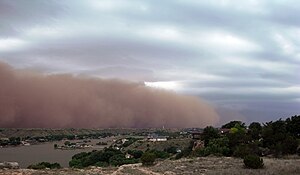 Image via Wikipedia
Image via Wikipedia During thunderstorm formation, winds move in a direction opposite to the storm's travel, and they will move from all directions into the thunderstorm. When the storm collapses and begins to release precipitation, wind directions reverse, gusting outward from the storm and generally gusting the strongest in the direction of the storm's travel.
When this downdraft, or "downburst", reaches the ground, dry, loose sand from the desert setting is essentially blown up, creating a wall of sediment preceding the storm cloud. This wall of sand can be up to 100 km (60 miles) wide and several kilometers in elevation. At their strongest, haboob winds can travel at 35-50 km/h (20-30 mph), and they may approach with little to no warning.
via: YouTube

